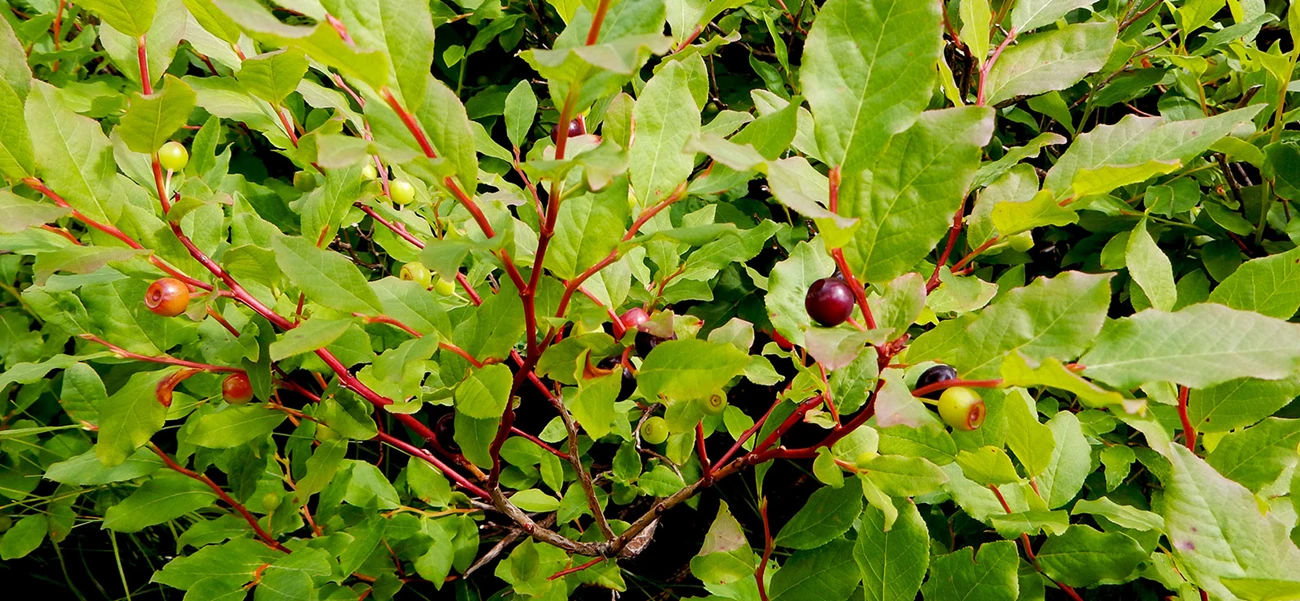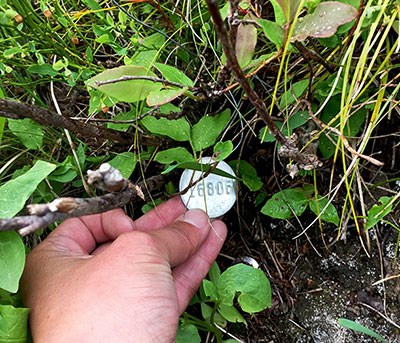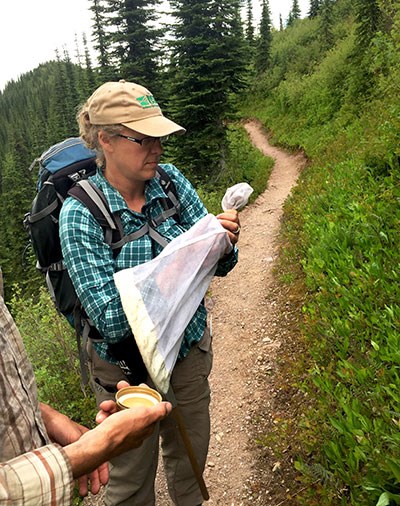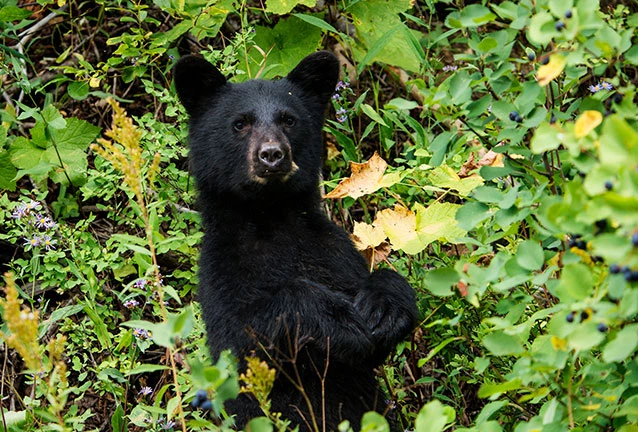By Robina Moyer
Article
Bears, Berries, and Bees: The Implications of Changing Phenology

USGS/Tabitha Graves
A warm June day finds me perched on a steep slope, crawling through the brush in search of a small, metal disc attached to a huckleberry plant. This early in the season, the plants look spindly and fragile. Their leaves have just emerged and they are several weeks away from producing the dark-purple berries that are iconic to Montana. After several minutes, I locate the tagged plant. It clings to the soil, growing on the exposed, rocky mountainside.

I begin counting the small, green discs that will later turn into plump berries. When I look up, the shift in scale from a single branch to the entire valley catches me off-guard and I’m momentarily dizzy. Taken by itself, the huckleberry plant in front of me seems impossibly delicate, but my glance across the mountain reminds me of how tough these plants actually are. Along with the countless other huckleberry bushes on this slope, this plant is a critical and intrinsic part of the landscape.
I am out on the aptly named Huckleberry Lookout Trail with U.S. Geological Survey (USGS) Research Ecologist Tabitha Graves, who is interested in how these berries relate to another iconic Montana species—the grizzly bear. Her previous work focused on grizzly bears throughout North America, including in Glacier National Park, but her current project takes a less direct approach to bear research. Bears in Glacier and the surrounding area are primarily vegetarian, and it is estimated that huckleberries comprise up to 15% of their diet. But as Graves began her investigation into how huckleberry production might impact bear behavior, it became clear that very little is known about huckleberry ecology.
“We still don’t have good predictive maps that tell us when, where, and how many huckleberries are out there,” Graves explains as we hike up Huckleberry Mountain. This is surprising, given their importance for both wildlife and people in Montana. Graves’s current project aims to change that by looking at the productivity and phenology, or seasonal timing, of huckleberry plants. Phenology is not a new field of study. For millennia, people have documented seasonal events, such as bird migrations and crop harvests. But in recent years, phenology has gained more attention in North America, as a warming climate has led to noticeable shifts in phenological events.
-
Huckleberry Phenology Project Goals
USGS Research Ecologist Tabitha Graves explains the goals of her current phenology research project.
- Credit / Author:
- NPS/Robina Moyer
- Date created:
- 10/01/2015
Graves’s goal is to develop a model that will combine phenology information with factors such as temperature, snow pack, rainfall, and elevation to predict berry production across a variety of spatial locations. Ideally, this model will help resource managers to forecast berry production and be an important tool as climate change leads to shifts in the timing, location, and productivity of this vital food source for bears. Graves hopes managers will be able to use this information to anticipate and minimize bear-human conflicts.
Today, our goal is to check on four of the phenology plots, each consisting of ten plants. We will identify which phenological stage the tagged plants are in, replace temperature loggers, and check each site’s remote camera. A camera is focused on a specific plant at each site, taking daily photos to document the plant’s developmental progression between visits. The cameras ensure that important events, such as when the plant emerges from snow, are captured and recorded. This data will be combined with each site’s elevation, slope aspect, and weather information to help Graves identify which factors are crucial to successful berry production.
-
Huckleberry Pollinators
Researcher Tabitha Graves describes how bumblebees are caught for identification.
- Credit / Author:
- NPS/Robina Moyer
- Date created:
- 10/01/2015
Graves has brought an insect net and specimen jars in case there is an opportunity to collect any bees. Looking at the lineup of gear, I realize how much it takes to collect information on a simple plant. But then, what I’ve learned so far is that huckleberries are anything but simple.
Graves’s enthusiasm for the project is infectious and I find myself thinking about the relationship between humans, huckleberries, bears, and bees in ways I have never before considered. If climate change causes the timing of the huckleberry’s flowering to shift, will the bees needed to pollinate them be able to adapt? If not, then berry production could plummet—even with the right weather conditions.
And even if huckleberries remain productive, an earlier berry crop could affect a bear’s ability to get sufficient calories in the fall, when it is trying to put on fat for the winter. In turn, bears may seek alternative food sources, possibly leading to increased conflicts with humans. Not to mention our love affair with huckleberries; changes in berry production have the potential to impact countless Montanans’ commercial and recreational endeavors. With such a vast array of consequences on the line, how is it possible that so little is actually known about these plants?
Many factors go into answering the deceptively simple question, “What are the right conditions for ideal huckleberry production?” Matters are further complicated by trying to collect baseline data when normal weather is no longer easy to define. Instead of seeing this as a problem, Graves embraces the challenge: “The kinds of conditions we’re experiencing this year are more typical of what’s anticipated in the future. We had a warm, dry spring. These conditions, along with increasing weather variability, are the kinds of things that have the potential to influence huckleberry productivity down the road.”

As we make our way through a dense thicket of huckleberries, a buzzing sound permeates the air. Bees—bumblebees! Graves quickly assembles the insect net while her assistant pulls out specimen jars. We all stalk the path for a few minutes, trying to pinpoint the bees’ locations. After spotting a bee cupping the urn-shaped huckleberry flower, Graves swoops in with the net, securing the bee with a deft flick of her wrist. The bee is transferred from the net into a jar and will be taken back to the office to be identified. It is an unfortunate sacrifice of the project, but will provide invaluable information.
Like so much in nature, the role of huckleberries is a complex one and the deficit of research is daunting. But after spending the day with Graves, it seems likely that many of these questions may soon be answered. Her passion and energy for the project are tireless and her easy-going demeanor allows her to take the challenges of a complex field project in stride. These qualities are contagious, even for someone who had never thought twice about the science behind a huckleberry.
Weeks later, I’m hiking in Glacier on a cool morning, traversing a trail high above Lake Ellen Wilson. The mountain peaks hold on tightly to a blanket of clouds, shrouding the valley in a gray fog. Just above the trail, a bush loaded with ripened huckleberries emerges from the mist. Suddenly, wherever I look, there are ripe berries, ready to be eaten. I pause to pick a few and savor their sweet, tart flavor.
Much further up the slope, a movement catches my eye and a black bear crosses toward a patch of huckleberries. I’m not the only one enjoying huckleberries this morning. For all their notoriety, it still amazes me that so little is known about these berries that are coveted by humans and bears alike. However, I feel confident that Graves’s research will soon shed light on this treasure of the northern Rockies.

NPS/Tim Rains
Downloadable pdf
2015 Science in the Crown NewsletterLast updated: October 27, 2021
